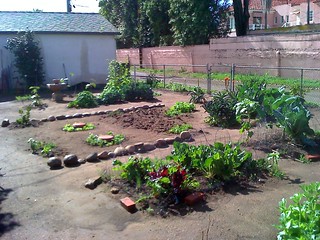It takes a lot of time and energy to build an amazing vegetable garden. When you move, you’ll want to try and take as many plants with you as possible. While tricky, you can move the majority of your vegetable garden without much of a problem. Here’s how to move your veggies without losing all of that hard work!

Prep Your New Space
If you have a nice garden spot at your new home, you’ll want to prepare the earth before you move your current garden. Dig holes where your veggies will go, make sure to use rich earth, and get your new garden ready just as you would an old garden spot.
Start With Pots
Purchase some very large and deep pots. Carefully uproot one plant at a time from your old garden, and replant it inside of a deep pot (making sure to keep roots intact). Pack new soil around each plant, so that every veggie is packed tightly and is ready to move. Try to uproot plants on a cool day that’s not too humid. Moving a garden on a very hot day will mean that you will have to water your plants frequently, so pick a day with some shade.
Add Water
Even the shortest move can do a number on plants, so you’ll have to make sure that your plants are well hydrated. Soak the bottom of each plant in water for up to twenty minutes (not overnight). This way, your plants will have a nice refreshing drink of water before you move anything. You can also use a garden hose to run water into each pot.
Check the Weather Forecast
You’re in luck if the day after you’ve planted your new garden is filled with rain clouds. Try and move your garden the day before a really big rainstorm. This way, your plants will integrate with the new soil quickly, become more than adequately hydrated, and have the best chance at survival. Above all else, be careful with your plants! Plants have a tough time traveling, so make sure to handle them with care.
Moving Companies and Plants
A professional moving company that does transport plants (some do not) should be able to move your veggies without a hitch. That said, it’s best if you can move each pot by yourself during the span of one day. This way, you can put your vegetables into the new earth without worrying about spills or other issues that might arise if your plants are placed in the back of a truck. Check with your moving company to see whether or not plants can be accommodated. But, again, we recommend moving your garden on your own.
Your New Spot
One of the most important steps to take when moving a vegetable garden is to prepare the new soil before you try to plant anything. If you have the time, get your soil tested by a local lab. A good lab can tell you what your soil needs in order to help plants flourish. Once you’ve added the recommended nutrients, you can be sure that your plants will grow by leaps and bounds (and you don’t have to lose all of that hard work!). Preparation is often the key when it comes to moving an old garden to a new spot (it also helps to pick the right spot, so pay attention to shade, sunlight, and other natural elements).
Packing It All Up
If you can make an arrangement with new tenants to move your garden after you move the rest of your stuff that is ideal. If not, try to move your garden before you move your other items (at least a week before your move). This way, you can focus on building up your garden before you have to focus on unpacking a whole home. The benefits of a vegetable garden far outweigh the time and effort you have to put into one, and you can move your garden safely if you follow the steps listed above.
A new garden spot means that you may be able to grow the best garden you’ve ever had. With newly tested soil, the right amount of sun and shade, and all the right nutrients, your new garden will flourish. Have you moved your garden? How did it go? We’d love to hear from you! And, keep in mind, that Exodus Moving and Storage can help you with all of your moving needs, so give us a call today for a free estimate!
